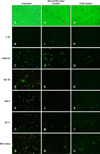Dear Editor:
Becker's nevus (BN) is an uncommon cutaneous hyperpigmentation with hypertrichosis that develops during adolescence and occurs primarily in young men1. BN appearing on exposed areas of the body may represent a distressing cosmetic handicap. However, treatment of BN is suboptimal and unfavorable. BN is known to be resistant to treatment with intense pulsed light or Q-switched laser2. Permanent hypopigmentation or complete repigmentation can be observed after treatment of BN with laser devices345. This study was conducted to investigate the in vitro and in vivo effects of Q-switched alexandrite laser irradiation on BN melanocytes.
Melanocytes were cultured from BN epidermis in a melanocyte growth medium according to a known method6. The cultured BN melanocytes were divided into three groups: untreated group, Q-switched alexandrite laser (Alex®; Syneron Candela, Irvine, CA, USA)-treated group, and 0.7 J/cm2 narrow-band ultraviolet B (UVB, Waldmann UV 801 BL®; Waldmann, Villingen-Schwenningen, Germany)-treated group. The protocol for treatment with Q-switched alexandrite laser was as follows: wavelength, 755 nm; spot size, 3 mm; fluence, 7 J/cm2; repetition rate, 2 Hz; overlapping, 10%. Immunocytofluorescence analysis was performed twice in the three groups, with antibodies against c-kit (1:50; Dako, Frederiksberg, Denmark), human melanoma black 45 (HMB-45, 1:50; Dako), melanocortin 1 receptor (MC1R, 1:100; Chemicon, Billerica, MA, USA), mel-5 (Signet, Dedham, MA, USA), microphthalmia-associated transcription factor (MITF, 1:50; Novocastra, Newcastle upon Tyne, UK), and NKI/beteb (Monosan, 1:50; Sanbio, Uden, The Netherlands). Skin biopsies were obtained from five patients with BN. In addition, skin biopsies were obtained from hypopigmented macules and repigmented macules of patients with BN after treatment with Q-switched alexandrite laser. The protocol for treatment with Q-switched alexandrite laser was as follows: wavelength, 755 nm; spot size, 3 mm; fluence, 7 J/cm2; repetition rate, 2 Hz; overlapping, 10%. Histological studies with hematoxylin-eosin stain and Masson-Fontana (M-F) stain and immunohistochemistry with antibodies against S-100 and c-kit were performed on the biopsy specimens.
The cultured BN melanocytes had slender cytoplasm with bipolar or tripolar dendritic processes (Fig. 1). After irradiation with Q-switched alexandrite laser, the cultured BN melanocytes were almost destroyed, but a few morphologically intact cells were seen (Fig. 1); meanwhile, after UVB irradiation, the cultured BN melanocytes had decreased density compared with untreated cells (Fig. 1). Like in epidermal melanocytes, c-kit, HMB-45, MC1R, mel-5, MITF, and NKI/beteb were well expressed in cultured BN melanocytes by immunocytofluorescence (Fig. 1). The expression of c-kit, HMB-45, MITF, and NKI/beteb in intact BN melanocytes after irradiation with UVB or Q-switched alexandrite laser was similar to that in untreated cells (Fig. 1). However, the expression of MC1R and mel-5 in the intact BN melanocytes was lower than that in untreated cells (Fig. 1). Like for other pigmented skin lesions, histological examination with M-F stain revealed an increase in pigmentation of the BN epidermis (Fig. 2). In addition, an immunohistochemical study showed the expression of S-100 and c-kit along the dermoepidermal junction of the BN skin (Fig. 2). However, the hypopigmented macules of BN produced by Q-switched alexandrite laser showed a negative reaction to M-F stain and antibodies against S-100 and c-kit (Fig. 2). The repigmented macules of BN, after treatment with Q-switched alexandrite laser, showed a linear positive reaction to M-F stain and a focal positive reaction to antibodies against S-100 and c-kit (Fig. 2).
Q-switched alexandrite laser irradiation targets dermal and epidermal chromophore for the treatment of pigmentary skin lesion including BN7. However, it is not easy to manage BN with Q-switched alexandrite laser. Permanent hypopigmentation or complete repigmentation can develop after laser treatment of BN. An in vitro study was performed using cultured BN melanocytes. The cultured BN melanocytes had the same characteristics as epidermal melanocytes, showing slender cytoplasm, with bipolar or tripolar dendritic processes, and expressing c-kit, HMB-45, MC1R, mel-5, MITF, and NKI/beteb. The cultured BN melanocytes, after treatment with Q-switched alexandrite laser, were almost destroyed, but some BN melanocytes with intact cytoplasm and dendritic processes were observed. Intact cells expressed c-kit, HMB-45, MITF, and NKI/beteb, but did not express MC1R and mel-5. Cytotoxicity, which causes change in the expression of cellular biomarkers, can be induced at 0.4 J/cm2 of narrow-band UVB8. In this study, cultured BN melanocytes were irradiated with 0.7 J/cm2 UVB. The expression of biomarkers in the UVB-irradiated BN melanocytes was similar to that in the cells after irradiation with Q-switched alexandrite laser. Usually, repigmentation of BN after laser treatment is thought to be caused by hormonal factors and higher hormonal receptor expression9. In addition, Q-switched laser-resistant BN melanocytes can be one of the causative factors of postlaser repigmentation of BN. Fewer BN melanocytes and similar pigmentation in repigmented skin were noted on histology and immunohistochemistry after treatment with Q-switched alexandrite laser. These S-100-and c-kit-positive cells may be Q-switched alexandrite laser-resistant BN melanocytes, with complete repigmentation. In conclusion, this study suggests that some BN melanocytes remain alive after treatment with Q-switched alexandrite laser, showing changes in expression of several biomarkers and playing an important role in cutaneous repigmentation.




 PDF
PDF ePub
ePub Citation
Citation Print
Print




 XML Download
XML Download